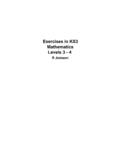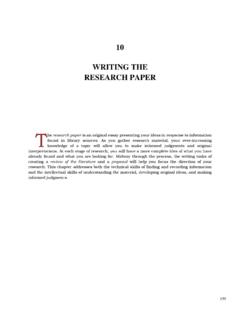Transcription of FREQUENTLY ASKED QUESTIONS—MULTIPLE INTELLIGENCES …
1 FREQUENTLY ASKED QUESTIONS MULTIPLE INTELLIGENCES AND. RELATED EDUCATIONAL TOPICS. Howard Gardner Introduction: Almost every day, I receive questions about multiple INTELLIGENCES theory. Some of the questions concern the theory itself, though many more deal with recommended practices or with questionable applications. The questions come from professors, teachers, parents, the usual sense, the questions come from scientists, artists, people in business, retirees, professionals and amateurs; and they emanate from many states and many lands. The questions used to arrive primarily by letter and phone; now, of course, they arrive as well by e-mail.
2 And whenever I speak publicly about the theory, whether in person or on radio or television or YouTube, a new set of questions greets me upon my return to the office. I field questions about other topics as well. Sometimes these are answered at or (see the bottom of this page for further references). Initially, I sought to answer each question individually. There were not that many; I learned from and enjoyed the process. More recently, however, it has become impossible to answer all of the questions individually, even with staff help. Routinely, I refer individuals to my writings or those of other persons familiar with the theory.
3 I have drafted generic letters that answer the most frequent questions for example, "Is there a test for multiple INTELLIGENCES ?" (Answer, "Not one that I. endorse"); and "Are there multiple intelligence' high schools? (Answer, "Many, but each has been developed by a group of practitioners, not by me ). When an interesting and novel question arises, I. sometimes write an answer of some length and then include it in a future publication. In the pages that follow, I respond to questions raised FREQUENTLY by those interested in the theory. I. also respond to some other FREQUENTLY ASKED questions about my work.
4 Some of these answers were initially developed in conjunction with Joseph Walters and Margaux Wexberg, to whom I give thanks. Others draw on material from my books Multiple INTELLIGENCES : The Theory in Practice, Multiple INTELLIGENCES : New Horizons and Intelligence Reframed. In a Nutshell: Q. Can you summarize multiple INTELLIGENCES ' (MI) theory briefly? A. I developed MI theory in the late 1970s and early 1980s. In doing so, I drew on evidence from a wide variety of sources, disciplines, and research tradition. I presented the theory for the first time in 1983, in my book Frames of Mind: The Theory of Multiple INTELLIGENCES .
5 The theory is a critique of the standard psychological view of intellect: that there is a single intelligence, adequately measured by IQ or other short answer tests. Instead, on the basis of evidence 1 from disparate sources, I claim that human beings have a number of relatively discrete intellectual capacities. IQ tests assess linguistic and logical-mathematical intelligence, and sometimes spatial intelligence; and they are a reasonably good predictor of who will do well in a 20th (note: NOT 21st). century secular school. But humans have several other significant intellectual capacities. In my original book, I described musical intelligence, bodily-kinesthetic intelligence, interpersonal (social) intelligence, and intrapersonal intelligence (understanding of self).
6 A few years later, I added the naturalist intelligence: the capacity to make consequential distinctions in the world of nature. I also have speculated about two other possible INTELLIGENCES : existential intelligence, the intelligence of big questions'; and pedagogical intelligence, the intelligence that allows human beings to convey knowledge or skills to other persons. For something to qualify as an intelligence, it has to satisfy the eight criteria laid out in chapter 4 of Frames of Mind. In comparing MI to traditional psychological view of INTELLIGENCES , I find it useful to invoke the metaphor of the computer.
7 Belief in a singular intelligence implies that humans possess a single general purpose computer, which can perform well (hi IQ), average (normal IQ) or poorly (low IQ). Belief in multiple INTELLIGENCES theory implies that human beings possess several relatively independent computers; strength in one computer does not predict strength (or weakness) with other computers. Put concretely, one might have high (or low) spatial intelligence and yet that does not predict whether one will have high (or low) musical or interpersonal intelligence. Q. What are the major scientific implications of the theory?
8 A. Two interesting implications. The INTELLIGENCES constitute the human intellectual toolkit. Unless grossly impaired, all human beings possess the capacity to develop the several INTELLIGENCES . At any one moment, we will have a unique profile, because of both genetic (heritability) and experiential factors. Identical twins will have similar cognitive profiles. But the profiles will not be identical; even though the genetic constitution is the same, identical twins have different experiences (even in utero!) and once born, they can be motivated to distinguish themselves from their genetic clone.
9 Q What are the major educational implications of the theory? A. It is important to stress that MI theory began as a psychological theory, one that also drew on brain and genetic knowledge in the early 1980s. I was surprised that the principal interest in the theory came not from psychologists but from educators. And that has remained largely true until today. Initially, I did not have strong ideas about how to apply MI theory to education. And indeed, no scientific theory can be translated directly into educational applications because education is suffused with values. 2 That said, I think that there are two principal educational implications: Individuation and Pluralization.
10 The first, individuation (also termed personalization), suggests that since human beings have their own unique configuration of INTELLIGENCES , we should take that into account when teaching, mentoring or nurturing. As much as possible we should teach individuals in ways that they can learn and we should assess them in a way that allows them to show what they have understood and to apply their knowledge and skills in unfamiliar contexts. Traditionally, individuation was possible only for families with means. Nowadays, with the easy accessibility of powerful digital devices, it is possible to individualize education for everyone.








